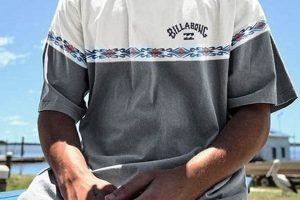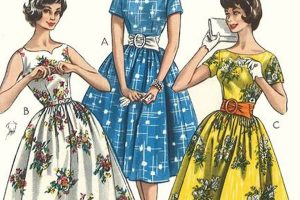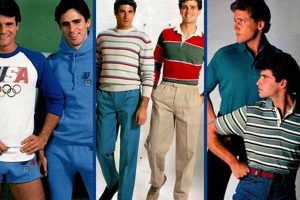Garments and accessories originally produced for armed forces personnel, possessing characteristics indicative of a previous era, are highly sought after. Examples include World War II-era bomber jackets, Korean War-era parkas, and Vietnam War-era fatigue pants. These items often exhibit unique construction techniques, durable materials, and historical markings.
The appeal of these goods lies in their inherent durability, historical significance, and distinctive aesthetic. They offer a tangible connection to the past, representing periods of conflict and innovation. Furthermore, their robust construction often surpasses that of contemporary apparel, providing longevity and practicality. Collectors, fashion enthusiasts, and history buffs alike appreciate the unique attributes these items offer.
Understanding the characteristics, sourcing, and preservation of these historical textiles is crucial for those interested in acquiring or studying them. The subsequent sections will delve into specific aspects of identification, care, and the market dynamics surrounding these collectible artifacts.
Tips for Acquiring and Maintaining Historic Uniforms and Gear
The following guidelines offer practical advice for individuals interested in collecting, preserving, and understanding garments and equipment from past military conflicts.
Tip 1: Authenticate Prior to Purchase: Thoroughly examine items for markings, labels, and construction techniques consistent with the claimed era. Consult reputable reference materials or experts to verify authenticity and avoid reproductions.
Tip 2: Consider Condition Carefully: Assess the degree of wear, damage, and repairs. While some wear is expected in vintage items, extensive damage can significantly impact value and longevity. Factor restoration costs into the purchase price.
Tip 3: Research Historical Context: Understanding the specific unit, campaign, or role associated with a piece enhances its historical significance and informs proper display or storage. Researching the item’s provenance adds value.
Tip 4: Employ Proper Storage Methods: Store items in a cool, dry, and dark environment to minimize deterioration from light, humidity, and pests. Acid-free tissue paper and archival-quality storage containers are recommended.
Tip 5: Practice Gentle Cleaning Techniques: Avoid harsh detergents or solvents. Spot cleaning with mild soap and water is often the safest approach. Consult a textile conservator for heavily soiled or delicate items.
Tip 6: Document Acquisitions Meticulously: Maintain detailed records of each item, including its provenance, condition, and any repairs or treatments performed. Photographs and appraisal reports are valuable documentation.
Tip 7: Be Aware of Legal Restrictions: Certain countries may have import or export restrictions on specific military artifacts. Research applicable regulations before acquiring or transporting items across borders.
Adhering to these guidelines will help ensure the preservation and appreciation of these valuable artifacts for generations to come. Careful attention to authentication, condition, historical context, storage, cleaning, documentation, and legal compliance is essential.
The concluding section will provide resources for further research and engagement with the field.
1. Authenticity
The authenticity of garments produced for past armed forces represents a critical determinant of value and historical significance. The presence of verifiable characteristics, such as original manufacturer’s markings, government issue stamps, and construction techniques consistent with the purported era, establishes an item’s legitimacy. The absence of such features casts doubt on its genuine nature, often relegating it to the realm of reproduction or pastiche. For example, a field jacket claimed to be from the Vietnam War era should exhibit the correct type of fabric, hardware, and nomenclature label associated with that period. Discrepancies in these elements suggest inauthenticity.
The assessment of genuineness often necessitates expert knowledge and careful examination. Subtle details, such as the type of stitching, the specific alloy used in buttons, or the font employed on labels, can serve as indicators of authenticity. The pursuit of genuine articles has led to the development of sophisticated methods for detecting counterfeits, including carbon dating of fabrics and microscopic analysis of dyes. Furthermore, verifiable provenance, tracing an item’s history back to its original source or owner, provides strong corroborating evidence of its authenticity.
Establishing the authenticity of vintage garments presents ongoing challenges. Skillful reproductions can mimic the appearance of originals, requiring meticulous scrutiny to differentiate between them. The value attached to authentic pieces underscores the importance of rigorous verification methods. This pursuit of authenticity preserves historical accuracy, ensuring that the items collected and studied accurately reflect the past.
2. Rarity
The limited availability of specific garments significantly influences their desirability and market value. Scarcity, stemming from various historical and logistical factors, elevates certain pieces beyond mere utilitarian objects into highly sought-after collectibles.
- Limited Production Runs
During wartime, certain specialized items were produced in limited quantities to meet specific needs. Garments designed for elite units or extreme environments, such as cold-weather gear or specialized flight suits, were not mass-produced and are now extremely scarce. For example, early-model paratrooper uniforms or experimental camouflage patterns are highly valued due to their limited initial production.
- High Attrition Rates
The rigors of military service, including combat and harsh environmental conditions, resulted in high attrition rates for clothing. Many items were damaged beyond repair or lost during operations. Consequently, surviving examples, particularly those in good condition, are exceedingly rare. Items associated with specific battles or campaigns, if they survived, represent a small fraction of the original issue.
- Discontinuation of Styles and Materials
Changes in military regulations, technological advancements, and material availability often lead to the discontinuation of specific uniform styles or the use of particular fabrics. Garments incorporating discontinued materials or representing obsolete uniform regulations become increasingly rare as time passes. For instance, uniforms made from specific types of wool or incorporating unique hardware designs that were later replaced are now considered valuable rarities.
- Geographic Limitations
Garments specific to certain geographic regions or theaters of operation can have limited availability. Uniforms or gear designed for specialized climates or environments. Their scarcity often leads to high value among collectors seeking to assemble complete sets or represent specific historical periods. Examples include arctic gear, jungle-specific items, or uniforms issued exclusively to forces stationed in particular overseas territories.
The interplay of limited production, high attrition, stylistic obsolescence, and geographic specificity contributes to the relative scarcity of particular garments. This scarcity elevates these historical artifacts beyond simple clothing items, transforming them into valuable historical relics that encapsulate periods, conflicts, and military innovations. Collectors and historians alike place a premium on these unique and infrequently encountered pieces.
3. Condition
The state of preservation of garments created for former military forces represents a paramount consideration in determining their value and historical significance. Condition encompasses a spectrum of factors, influencing both the aesthetic appeal and the artifact’s ability to convey its historical context.
- Material Integrity
The structural soundness of the fabric, stitching, and hardware directly impacts the overall condition. Tears, fraying, weakened seams, and corrosion diminish the value and usability. For example, a wool overcoat with significant moth damage or a canvas pack with rotted straps would be considered in poor condition, regardless of its historical rarity. The presence of original, intact materials is highly desirable.
- Original Features
The presence and functionality of original components, such as buttons, zippers, labels, and insignia, significantly influence condition assessment. Missing or replaced elements detract from the artifact’s authenticity and completeness. A World War II-era flight jacket retaining its original Talon zipper and manufacturer’s label would be considered in superior condition compared to one with replaced components. The originality factor enhances historical accuracy.
- Evidence of Wear and Use
While some degree of wear is expected in vintage garments, excessive damage or alterations negatively affect condition. Stains, fading, repairs, and modifications can obscure original features or compromise the structural integrity. A field uniform exhibiting significant staining from combat or extensive field repairs would generally be considered in fair to poor condition, despite its potential historical significance. The nature of wear impacts value.
- Restoration and Preservation
The quality and extent of any restoration efforts influence the overall assessment. Professional conservation techniques aimed at stabilizing the garment without altering its original character enhance its value. Conversely, poorly executed repairs or over-zealous cleaning can diminish its historical integrity. Garments treated by qualified textile conservators are typically considered in better condition than those subjected to amateur restoration attempts. Responsible preservation adds value.
These interconnected elements collectively determine the perceived condition of historical garments. The degree to which an item retains its original features, structural integrity, and evidence of its past use defines its place within the spectrum of collectibility. Assessing condition requires careful consideration of materials, originality, wear, and restoration, ensuring that the value accurately reflects the historical and aesthetic significance of the garment.
4. Provenance
The established history of ownership and usage significantly impacts the valuation and historical importance of articles. Provenance provides a verifiable link between a specific garment and individuals, events, or military units, transforming an otherwise generic artifact into a unique historical record. A uniform documented as belonging to a decorated officer during a specific campaign, for example, carries significantly more historical weight than an identical uniform lacking such documentation. This direct connection to a person or event amplifies its narrative power.
The determination of an article’s lineage typically relies on several forms of evidence: documentation such as military records, letters, photographs, and personal accounts. Inscriptions or markings on the garment itself, identifying the owner or unit, offer corroborating evidence. Matching patterns between the article and known historical photographs can also support provenance claims. The absence of verifiable information renders authentication more challenging and impacts its perceived value. Consider a flight jacket bearing the name and squadron insignia of a pilot known to have flown in a significant battle. Such a verifiable connection elevates the piece from a generic garment to a tangible relic of a specific moment in history.
Understanding the influence of lineage is crucial for both collectors and historians. It provides a framework for evaluating authenticity, significance, and potential ethical considerations. Establishing provenance requires meticulous research and careful analysis of available evidence, presenting challenges in cases where documentation is scarce or incomplete. Despite these hurdles, the effort to establish a verifiable history enhances understanding of the article and its role in a broader historical context, ultimately preserving its legacy for future generations.
5. Material
The composition of historical garments is intrinsically linked to their value and historical accuracy. The type of fabrics, dyes, and hardware employed in the production of military apparel directly reflects the technological capabilities, resource availability, and strategic priorities of the era in which they were created. For instance, the transition from wool to synthetic fibers in uniform construction reflects advancements in textile manufacturing and the need for lighter, more durable materials during the mid-20th century. Analyzing the composition of a World War II-era field jacket reveals insights into wartime resource allocation and the challenges of providing adequate clothing to troops stationed in diverse climates.
The practical significance of understanding the materials lies in the ability to authenticate and preserve items. Identifying the correct type of weave, fiber content, and dye composition can assist in determining the garment’s age and origin. Furthermore, knowledge of the materials informs appropriate conservation methods. For example, improper cleaning agents can damage specific vintage fabrics, leading to irreversible deterioration. Recognizing the difference between natural and synthetic fibers allows for the application of targeted preservation techniques, ensuring the longevity of these historical artifacts. Ignoring the material science of vintage military clothing can lead to misidentification, improper care, and ultimately, the loss of valuable historical data.
In summation, the materials used in the production of historical military garments are not merely aesthetic considerations; they constitute a critical component of the historical record. Understanding the composition, properties, and degradation mechanisms of these materials provides essential insights into the past and informs responsible preservation practices for the future. The challenges in this field lie in the ongoing development of analytical techniques and the ethical considerations surrounding the treatment and handling of delicate historical textiles. Continued research in this area is vital for safeguarding these tangible representations of history.
6. Construction
The method of assembly and fabrication significantly determines the durability, functionality, and historical accuracy of garments produced for past armed forces. Construction techniques, including stitching patterns, seam finishes, and the integration of hardware, directly reflect the manufacturing capabilities and performance requirements of the period. For example, reinforced seams and bar-tacked stress points, commonly observed in garments designed for arduous field conditions, demonstrate an emphasis on durability and longevity. Variations in construction methods, arising from technological advancements or cost-saving measures, can serve as valuable indicators of an item’s age and origin. The use of specific types of sewing machines, stitch densities, and reinforcement methods distinguishes between different production eras.
Analysis of construction details offers practical insight into the intended use and performance characteristics of historical military apparel. Garments designed for extreme cold-weather environments, for example, often feature layered construction, tightly woven fabrics, and specialized closures to provide thermal insulation and protection from the elements. Conversely, uniforms intended for tropical climates may incorporate lightweight, breathable fabrics and ventilation features to enhance comfort and reduce heat stress. Examining the placement and design of pockets, closures, and reinforcement patches reveals the intended functionality and ergonomic considerations of the garment. A World War II-era paratrooper uniform, with its reinforced jump suit construction, multiple pockets for carrying equipment, and specialized leg straps, exemplifies the functional design principles of the time. These construction features are not merely aesthetic; they represent a crucial aspect of the garment’s design and purpose.
Understanding the construction methods is essential for authentication, preservation, and restoration. The presence of period-correct stitching patterns, seam finishes, and hardware components supports the legitimacy of historical military garments. Conversely, discrepancies in construction can indicate the presence of later repairs or alterations. Accurate reproduction necessitates meticulous attention to construction details, including the precise replication of original stitching patterns, seam allowances, and reinforcement techniques. Furthermore, understanding the inherent strengths and weaknesses of vintage construction informs appropriate storage and handling practices, minimizing the risk of damage or deterioration. Proper preservation practices, informed by knowledge of construction techniques, ensure the continued survival of these tangible historical artifacts.
7. Era
The specific period from which a garment originates constitutes a foundational element in defining its value and historical significance. The historical context imparts unique characteristics influenced by prevailing technologies, material availability, and military doctrines. Apparel from World War I, for instance, reflects the textile production capabilities and the trench warfare conditions of that time, exhibiting distinct features such as heavy wool fabrics and reinforced construction. Conversely, uniforms from the Vietnam War era demonstrate the introduction of synthetic materials, camouflage patterns adapted for jungle environments, and lighter construction techniques designed for increased mobility. Thus, the time of origin leaves an indelible mark on the construction, materials, and functionality of military attire. Acknowledging the time is imperative for accurate identification and assessment.
The time influences market value, collector interest, and preservation methods. Pieces from particularly significant historical periods or conflicts often command higher prices due to their increased historical relevance and potential rarity. Understanding the time also guides appropriate storage and conservation efforts. Materials used in earlier periods, such as natural fibers and specific dyes, require different preservation techniques than those used for synthetic materials common in later eras. Accurate dating is therefore essential for maintaining the integrity of historical textiles. Moreover, research into the time provides context for understanding the garments original purpose and how it was used by military personnel. Examples include examining patterns of wear and tear, modifications made in the field, and associated equipment, which offer valuable insights into the daily lives and experiences of soldiers during specific conflicts.
Accurately identifying the time necessitates thorough research and detailed examination. Challenges arise from the presence of reproductions, the scarcity of verifiable documentation, and the evolving nature of military regulations. However, the effort invested in understanding the temporal context yields significant benefits, allowing for a more nuanced appreciation of the garment’s historical value and its connection to broader social, political, and technological developments. Further study of specific time periods and their associated military attire will enhance comprehension of the intricate relationship between fashion, history, and the armed forces.
Frequently Asked Questions About Collectible Military Garments
The following section addresses common inquiries regarding the acquisition, authentication, and preservation of antique military attire. The objective is to clarify prevalent misconceptions and provide substantiated guidance for enthusiasts and collectors.
Question 1: How can one differentiate between a genuine antique military garment and a reproduction?
Careful scrutiny of construction techniques, materials, and markings is crucial. Authentic garments typically exhibit manufacturing details and materials consistent with the purported era. Consult reputable reference materials and seek expert opinions when necessary.
Question 2: What factors determine the value of a vintage military uniform?
Value is influenced by factors such as rarity, condition, historical significance, and provenance. Garments associated with notable individuals or events command higher prices. Impeccable preservation enhances the overall value.
Question 3: What are the recommended methods for storing vintage military textiles?
Store garments in a cool, dry, and dark environment. Use acid-free tissue paper and archival-quality storage containers to prevent deterioration from light, humidity, and pests.
Question 4: Can vintage military clothing be safely cleaned?
Cleaning should be approached with caution. Employ gentle cleaning techniques, such as spot cleaning with mild soap and water. Avoid harsh detergents or solvents. Consult a textile conservator for heavily soiled or delicate items.
Question 5: Are there legal restrictions on owning or exporting military artifacts?
Certain countries may have import or export restrictions on specific military artifacts. Research applicable regulations before acquiring or transporting items across borders. Failure to comply can result in legal penalties.
Question 6: Where can one find reliable resources for researching the history of military uniforms?
Consult reputable military museums, historical societies, and specialized libraries. Online archives and scholarly publications offer valuable insights into the evolution of military attire.
In summary, successful acquisition and preservation of antique military garments require diligent research, careful assessment, and adherence to established conservation practices. Authentication is paramount, and proper storage is essential for ensuring the longevity of these historical artifacts.
The concluding section will provide a curated list of resources for further exploration.
Conclusion
This exploration of garments originally produced for armed forces, characterized by age and historical significance, has traversed key facets of their identification, value, and preservation. From authentication and condition assessment to the critical roles of provenance, material composition, construction techniques, and the historical era, a comprehensive understanding of the complexities inherent in garments of this nature is crucial. This understanding enables informed decisions regarding acquisition, care, and appreciation of these tangible relics of military history.
The ongoing preservation and study of garments from past armed conflicts serve not only as a tribute to the individuals who wore them but also as a vital resource for understanding the evolution of military technology, strategy, and social history. Continued research and responsible stewardship are essential to ensure that these artifacts endure as valuable educational tools for future generations.







